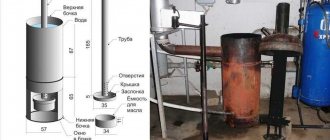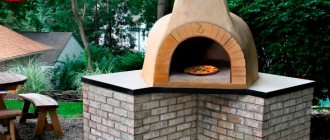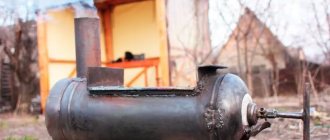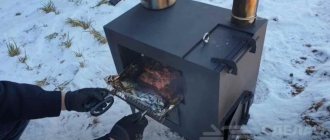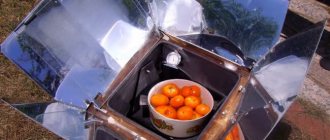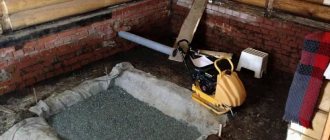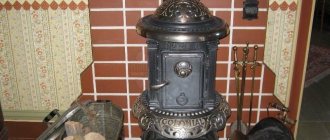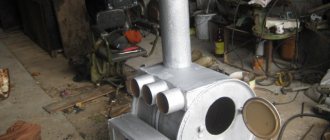Savig
7762 0 1
Savig August 20, 2016Specialization: master of interior finishing works. I am well versed in power tools for repair and construction. Formerly a teacher at a radio engineering college.
Russian stove from an old cast iron bathtub
There are never many stoves in a well-equipped dacha, especially good ones, and it’s a pity to sell an old cast-iron bathtub for scrap. These are exactly the thoughts that came to me after installing a brand new quaril font in my apartment. And I decided not to get rid of the previous massive tank, but to take it to a country site and convert it into an efficient stove structure. Next I will describe how it happened.
Advantages of cast iron
A stove made from a cast iron bath will last almost forever. Even enamel will not burn out quickly. In Soviet times, enamel was applied in two layers. The enamel contained quartz sand. After coating with enamel, the product was baked in an oven at a temperature of more than 800 degrees. The sand melted, and this coating served for decades. The enamel could only be damaged by a strong blow from a heavy object.
Cast iron bathtub is durable enough to make a stove out of it
In addition, cast iron has a high heat capacity, accumulates and releases heat well. Not afraid of corrosion. The industry produces fireboxes and grates from cast iron, since it does not burn out for a long time, unlike steel. But cast iron is a rather brittle metal.
Manufacturing
Making homemade equipment begins with drawing up a drawing of a metal sauna stove. It is necessary to indicate the components and main dimensions. The manufacturing process consists of several main stages.
Tools and materials
After drawing up the drawing, you can go to the hardware store for materials and tools:
- grinder with metal discs;
- welding machine with electrodes;
- a set of measuring instruments;
- sheets of metal;
- metal corners;
- doors for the combustion chamber, blower;
- fittings for making a grate;
- chimney pipes.
Additionally, you will need a metal water tank, which must have a drain valve, a water supply hole with a plug.
Preparation
Before you begin assembling homemade furnace equipment, you need to cut the metal sheets into component parts according to size. After this, it is advisable to temper the steel. To do this, you need to perform several steps:
- Heat metal parts.
- Allow the metal to cool on its own.
When steel tempering is completed, you need to check the dimensions of the parts. They shouldn't change much.
Making a firebox
The firebox can be made from a large diameter metal pipe or made from individual sheets of metal. Both manufacturing methods need to be considered.
Assembling a firebox from separate sheets of metal:
- Cut metal sheets to create the body.
- Separately weld the two parts of the box.
- Secure reinforcement between the parts.
- Weld the box parts together. Make two rectangular holes in the front part - one above the grate, the other below it.
- Make holes in the holes.
- Drill a round hole in the top of the box for the chimney.
Assembling a firebox from a large diameter pipe:
- Place the handset in a vertical position. Cut it into two parts.
- Attach the reinforcement to the surface of the lower part to form a grate.
- Weld the two pieces of pipe together.
- Cut two holes above and below the grate. Secure to the door holes.
- Make a hole for the chimney in the upper part of the homemade firebox.
When the combustion chamber is ready, you can begin assembling the heater.
Pipe stove frame
How to make a heater?
There are two methods for making a heater. First assembly method:
- If homemade stove equipment is made from a large-diameter pipe, you can place the heater inside it, above the combustion chamber. To do this, you need to cut an additional door above the firebox.
- Weld the fittings so that stones that will be heated can be poured over the combustion chamber.
- A tank can be mounted on top of the entire structure. The stones are placed inside the oven, the door is closed, and the wood is set on fire.
Second assembly method:
- If a water tank is not needed, you can place the heater on top of the stove, around the chimney.
- Attach the smoke exhaust pipe to the hole made. Weld the walls for the heater along the contour of the metal box on top.
After this, you can pour special stones inside the homemade heater.
Assembling a tank for heating water
When assembling a homemade stove with a water tank, the container is placed above the overall structure of the stove. On top of the heater you need to weld a metal plate 10 mm thick. Make a hole in it for the chimney. After this, weld the water tank from separate metal sheets. Make a hole on the side for the drain valve.
Installation of the structure
After assembling a homemade stove, you need to properly install it in the bathhouse. To do this, you need to take into account some rules:
- Choose a location so that the stove is away from the walls.
- For the foundation you need to make a masonry of refractory bricks.
- Adjacent surfaces should be covered with a layer of non-combustible material, a sheet of reflective steel.
- To improve heat transfer, you can line the stove with a layer of red brick. In this case, you need to leave a distance between the metal and brick surfaces.
- To protect bathhouse visitors from burns, you can assemble a wooden fence. The wood must be pre-impregnated with fire-resistant impregnations.
When installing a chimney, you need to take into account that the pipe will get very hot. Therefore, it is necessary to make additional insulation where the pipeline passes through the ceiling and roof.
Cutting the bathtub
It is best to saw the bathtub outdoors, after turning it upside down. Cast iron is a brittle metal, so the procedure requires care. The cutting is done with a grinder. Buy several cutting discs at once. We make markings, and then lightly cut the enamel along the line so that when a full cut is made, chips do not form. We saw through the cast iron at a slight angle and make sure that the tool does not heat up. We take breaks. To prevent the halves of the sawn tub from pinching the disk at the final stage of cutting, place supports made of wood or brick along the edges of the cut.
Bathroom cutting is done with a grinder
Stage No. 2: cutting the cast iron font
I would like to warn you right away that this process is very labor-intensive, requiring great patience and caution , since during its implementation you can break the instrument and tear the disc, as a result of which there is a high probability of serious injuries to people nearby.
In my execution it looked like this:
Schematic instructions for sawing a cast iron bathtub
- To begin with, I laid the bathtub on the ground upside down for ease of further operations;
If you cut containers indoors, be sure to cover the walls and furniture with plastic film or old rags, otherwise cast iron dust will settle on them, which is almost impossible to remove.
- Strictly in the middle I drew a straight line with a marker , marking the location of the cut;
The cutting line should be strictly in the middle
- Next, strictly following the applied markings, using a grinder, I carefully made a cut into the enamel layer , the depth of which, as a rule, ranges from 1.5 to 2.5 mm. If you immediately start sawing the cast iron itself, then chips will form on the enamel covering it;
Scheme of cutting the enamel layer
- Now I moved on to sawing the font itself and did it slowly, regularly giving the tool rest. Believe me, the price of haste here can be very high; the saved 20-30 minutes will not replace your burnt angle grinder.
Furnace foundation
The type of foundation depends on the total weight of the furnace:
- A brick base is suitable for a light stove. The bricks are laid on edge and bonded with mortar. Cement grade for binder mortar is not less than M300;
- for a heavy furnace weighing more than 700 kg, a self-leveling foundation with a depth of at least 50 cm will be required. Formwork is made and filled with liquid concrete with or without filler. The filler will be fine broken brick or crushed stone.
The stove can only be built on a strong and heat-resistant base.
The top of the base is placed flush with the floor or 15 cm below the floor level. To protect the base from moisture, the bottom and walls of the formwork are covered with roofing material and all joints are coated with bitumen.
Advice. The base should protrude 50 cm beyond the boundaries of the stove. In front of the combustion chamber, 1.2 m of space should remain free.
Preparatory work: choosing an installation site and laying the foundation
Cut parts from steel sheets must be checked for the absence of burrs and sharp metal protrusions, as they will interfere during welding
You should also pay attention to the size of the cut elements
When choosing a place to install the stove, you should take into account that it is better to install these units in the corner of the room away from walk-through doors and windows. If such a stove is intended for a bath or steam room, then it can be installed behind a small partition. This will additionally protect against accidental contact with hot oven surfaces.
Option for a bath
It is best to build the foundation for the furnace together with the building under construction. However, if the heating structure is planned to be installed indoors, it is necessary to dismantle the floor to the very foundation. In this case, logs can be cut only after the foundation has been erected to their level.
Over time, the building shrinks, and otherwise the base of the furnace will crack and the unit will warp.
To lay the foundation for a brick-lined stove, you must perform the following steps:
Make markings for the future dimensions of the oven. It is more convenient to take notes on the wall. Disassemble the floor covering. You need to get to the ground itself. At this stage, do not saw the wooden joists.
In accordance with the markings on the wall, dig a pit 50 cm deep and 75 cm wide. If there is a large amount of sand in the ground, the walls of the pit may crumble. To avoid this, you need to cover them with roofing felt or polyethylene. Carefully compact and level the bottom of the pit. Pour medium-fraction gravel inside to create a layer 250 mm thick. Lay waterproofing on top of it - roofing felt. Then fill in a layer of sand equal to 150 mm. It needs to be compacted. Please note that wet sand compacts better.
Make formwork for liquid concrete from boards or OSB boards. If it is made of boards, then concrete can pour out through the cracks or earth can be poured inside. To prevent this, the inner surface of the formwork can be covered with polyethylene.
Now it is necessary to make a metal frame that will strengthen the concrete base. For this you need reinforcing bars with a thickness of 8 to 10 mm. From them it is required to make a three-dimensional structure consisting of two gratings connected at a distance of 200 mm parallel to each other. The width of the cells should be no more than 150x150 mm. The intersections of reinforcing bars can be strengthened by welding, wire or plastic clamps.
Install the finished metal frame inside the formwork. It should be noted that this structure must be placed at a height of 50 mm above the waterproofing. To do this, you can drive wooden stakes or pieces of reinforcement perpendicular to the base. Attach a metal frame to them. You can use halves of bricks for this, which will create the desired height for placement. Pour the concrete mixture. The M 300 or M 400 brand is suitable for this.
Care should be taken to ensure that all elements of the reinforcement frame are hidden under a layer of concrete. During the process of pouring the foundation, air bubbles are formed, which must be removed by bayoneting or using a deep vibrator. Cover the poured mixture with polyethylene
This is necessary for the foundation to harden evenly. If this is not done, moisture will evaporate from the top layer of concrete. This can cause the hardened base to crack and lose its strength. After 8–10 days, the foundation will harden. Clean the frozen base from dust and debris. Cover with waterproofing material. Ruberoid or thick polyethylene is suitable for this. On top, make a continuous layer of fire-resistant red brick. When the level of the masonry reaches the joists, they must be sawed down so that the wooden ends lie on the concrete base.
Furnace No. 1
This version of the stove is capable of heating a bathhouse of 7 square meters. m to 80 degrees in just a couple of hours. To build a stove you will need scrap metal: a cast iron bath, a gas cylinder and a metal drum from a conveyor belt with a diameter of 40 cm. The drum can be replaced with a gas cylinder or pipe - this will be the combustion chamber. The sequence of work is as follows:
- A concrete foundation is being poured for the future furnace.
- The end of the bathtub is cut off.
- We make a combustion chamber: holes are drilled at the bottom of the drum. A box is welded to cover the holes and serve as an ash pit.
- We put the door on the firebox. You can use this spare part from an old stove.
- A gas cylinder is welded vertically at the opposite end of the drum.
- Now the resulting structure is placed in the bath.
Brickwork around the bathtub - A chimney pipe is welded to the cylinder.
- Lay the foundation with bricks to the height of the bathtub. Clay mortar is used for binding.
- After the masonry has dried, it is decorated with ceramic tiles. Tile adhesive is selected that is heat-resistant.
- Stones with a fraction of 7 to 15 cm are poured into the bathtub. Granite or pink quartzite. The stones quickly gain temperature and give off heat for a long time. Quartzite releases chemical compounds into the air that normalize blood pressure and metabolism. This bathtub can hold approximately 350 kg of stones. Bathhouse technologists claim that this number of stones is enough for a bathhouse of 10 square meters. m.
Advice. If you weld a flat metal platform to the cylinder, you will get a stove for heating the kettle.
Stage No. 4: finishing
Here I had two tasks:
- Insulate the stove structure even more;
- Decorate the building, making it an excellent addition to the country interior.
And I started:
- I mixed a solution of clay and sand in a ratio of one to two;
The composition of clay and sand tolerates high temperatures well
You can also add some lime to the mix. This will reduce the risk of cracks appearing during the hardening of the finishing layer.
- I covered the cooking compartment with a steel mesh , the mesh size of which is 20 mm, and fixed its edges to the brickwork using self-tapping screws and plastic dowels. Now the clay plaster applied on top will not slide down the smooth cast-iron surface, and when it dries, it will have sufficient strength;
- By this time, the mixed mixture had reached the desired consistency, and using a spatula I applied the first finishing layer , which I did not smooth;
The first layer is ready and drying
- After the clay had set, I completed the final finishing , then moistened the spatula and carefully leveled the created coating. In total, my cladding was approximately 70 mm thick;
- After hardening I whitewashed the fur coat , adding to the similarity of the appearance of the structure with ancient stoves.
Oven after whitewashing
Also, in the future, I also want to cover the brickwork with ceramic tiles, but in order to save money, I don’t want to specifically purchase expensive materials for this. Therefore, I’m waiting for the time to renovate the bathroom at the dacha to use the ceramics removed from its walls.
Furnace No. 2
From a cast iron bath sawn into two parts you can make a combustion chamber for a sauna stove. You will need one half, the second can be used for the fireplace.
- We are laying out the foundation.
- We install half of the bathtub with the dome up. The cut edge is inserted into the wall from where the firebox will be produced. The rest of the bath remains in the steam room.
The process of building a stove from half a cast iron bath - We fill the hole with a brick wall, into which we build the doors of the combustion chamber and the blower.
- Now we build a brick wall around the perimeter of the bathtub, flush with the bathtub. The distance from the bathroom to the wall is taken from 8 to 15 cm.
- We fill the space between the cast iron container and the brick wall with stones after the brickwork has completely dried. The stones will heat up and give off heat.
The remaining half can be used to build a fireplace. Cast iron can easily withstand brickwork if you line the fireplace with an arched vault. Moreover, for this you do not need to make a complex template from plywood. The front part is decorated with a portal. The chimney is removed. You can make the fireplace closed by installing a transparent door on the firebox and admire the flames.
Advice. Cast iron and red ceramic bricks have different coefficients of thermal expansion. Therefore, when constructing brick walls, expansion joints are provided, which are filled with asbestos or fire-resistant basalt cardboard.
Alternative modifications
In fact, these are not even modifications, but, on the contrary, somewhat stripped-down options, which, nevertheless, can also be very useful in the household. Moreover, both of them can be realized from one vessel:
- For example, how to make a bath with a cast iron grill stove? After all, fried meat cooked over an open fire is simply amazing. For this it will be enough:
- Take the half of the bathtub that does not have a drain hole and attach another pair of legs to the cut edge for structural stability;
- Place a suitable sized grill on top. It is not at all necessary to fix it “tightly”; on the contrary, the removable version is more convenient to use and maintain;
- That’s it, through the open façade you add firewood or remove coals, put pork, lamb or chicken on top, and heat-intensive cast iron helps create the temperature necessary for frying;
- You can also make an effective stove for a bathhouse from a cast iron container:
- Lay the bathtub upside down so that its main part is in the steam room on a pre-prepared concrete base, and the cut goes into the next room;
- Inside, install a grate with the help of corners, and cover the facade with a metal sheet equipped with doors for the firebox and ash pan;
- Install a chimney pipe with exit outside the bathhouse area. You can first weld a small horizontal pipe into the facade, and then use an elbow to bring the chimney vertically to the roof;
- In the steam room, build a brick wall around a cast iron container at a distance of 10 cm and as high as the tank itself;
The process of installing a stove-stove from an old cast-iron font
- Fill the gap between the bricks and the bathtub with stones, which, when heated, will provide the necessary heat.
Furnace No. 3
The third version of the stove is often used as a garden barbecue and for cooking in the summer. If the upper chamber is filled with stones, then such a design will replace a traditional stove in a small bathhouse, so we will not ignore this model.
- The foundation for the furnace is being poured.
- The bathtub is sawn into two identical components.
- Supports are placed on the foundation if you want the stove to be higher.
- The first half of the bath is installed. A sheet of metal with a thickness of at least 5 mm is laid on top, which will completely cover the upper and lower compartments and serve as a hob.
Construction of a barbecue stove from a cast iron bath - We cut the chimney pipe into the sheet and weld it along the contour.
- We install the second half on top with the bottom up, having previously cut a hole for the chimney.
- We glue the metal sheet and the halves of the cast iron device with high-temperature sealant. This will prevent smoke from entering the upper chamber.
- We clamp both parts with clamps and drill holes along the contour for 10 mm bolts. We fasten both parts of the bathtub and the metal sheet.
- We lay a brick pedestal under a three-wall oven.
- The grate is installed 15 cm from the bottom of the combustion chamber. If the grate size is small, then two corners are welded to install it.
- The front part is covered with a sheet of metal or brickwork with a door installed opposite the combustion and ash chambers.
Finished product from cast iron bathtub and sheet metal - A metal shutter is made according to the size of the upper chamber. In this form, the chamber can be used as an oven.
- Now all that remains is to give the product a noble appearance: cover the brick with tiles or plaster.
Such non-standard designs are easy to manufacture and require minimal financial costs. An item that has served its purpose will get a second life, and you will receive a convenient and practical stove that will serve you faithfully for many years.
Stage No. 1: preparation of tools and materials
As for transporting the bathtub to the dacha, the most difficult thing was to bring it to the trailer. Cast iron is incredibly heavy and has the magical property of gaining mass with every step you take. But somehow, my comrades and I, nevertheless, put the “hippopotamus” into a prepared vehicle and I delivered it to the site of further work.
Only after everyone had suffered as loaders did the brilliant idea come to me that it was necessary to saw the font in the bathroom, because this would still need to be done in the future to create a stove. But two halves are much more convenient and easier to carry than the entire cast iron product.
It is better to cut the bath in advance in the apartment
After delivering the main “beast”, I set about preparing all the other supplies necessary to complete the plan:
Tools
| Name | Purpose |
| Angle grinder for working with wheels with a diameter of 230 mm | Using cutting and grinding wheels |
| Cutting wheels for working with metal | Cast iron cutting |
| Grinding wheels | Sanding sharp cut edges |
| Electric drill | Drilling the holes required for the bolts |
| Trowel | Carrying out masonry work |
| Mounting gun | Using a tube of sealant |
| Spirit level | Control of the horizontal and vertical of the created structure |
| Hammer | Multidisciplinary |
You will have to work not only with metal
When working with a cast-iron bathtub cast back in Soviet times, I recommend using only high-quality power tools from well-known foreign brands, since cheap Chinese copies simply may not withstand such a difficult confrontation and burn out.
The Bulgarian will withstand all the stress in the battle with cast iron with dignity
Materials
In addition to the cast iron container itself, I needed:
| Name | Purpose |
| Five-millimeter thick metal sheet | Chamber separation |
| Brick | Creating a reliable base for the stove |
| Grate | Arrangement of the combustion chamber |
| Clay and sand | Mixing masonry mixture |
| Heat-resistant type sealant | Sealing joints |
| Bolts and nuts | Connecting structural elements |
| Metal pipe with a cross section of 110-120 mm | Creating a chimney |
An example of a steel pipe with a diameter of 110 mm suitable for making a chimney
In addition to all of the above, I also recommend preparing safety glasses, a respirator and construction gloves. Their use during work will protect you from metal dust, scale and splinters.
Examples of protective equipment
Sauna stove made of cast iron bath: photo
Potbelly stoves - proven and simple designs
Potbelly stoves were a hit of the 20s of the last century. At that time, these stoves competed with brick stoves and were installed everywhere, even in apartments. Later, with the advent of centralized heating, they lost their relevance, but are used in garages, dachas, and for heating utility or outbuildings.
Sheet metal
Potbelly stoves from a cylinder, barrel or pipe
The most suitable material for making a potbelly stove for a garage is propane cylinders or a pipe with a thick wall. Barrels are also suitable, but you need to look for ones that are not very large in volume and have a thick wall. In any option, the minimum wall thickness is 2-3 mm, the optimal is 5 mm. Such a stove will serve for many years.
By design they are vertical and horizontal. It is more convenient to burn horizontally with firewood - longer logs will fit. It’s easier to make one extended upward, but the firebox is small in size, so you’ll have to cut the wood finely.
A potbelly stove for a garage can be made from a cylinder or pipe with a thick wall
Vertical
First, how to make a vertical stove for a garage from a cylinder or pipe. Divide the selected segment into two unequal parts. Below is a smaller one for collecting ash, above is the main one for storing firewood. The following is the order of work:
- Cut out the doors. Small at the bottom, solid at the top. We use the cut pieces as doors, so we don’t throw them away.
- We weld the grates in the chosen place. Usually this is steel reinforcement cut into pieces of the required length with a thickness of 12-16 mm. The reinforcement installation step is about 2 cm.
- Weld the bottom if there is none.
- We cut out a hole in the lid for the chimney, weld a strip of metal about 7-10 cm high. It is better to make the outer diameter of the resulting pipe fit standard chimneys. Then there will be no problems with the installation of the chimney.
- We weld the lid with the welded pipe into place.
- Using welding, we attach the locks and hinges to the cut-out door pieces and install it all in place. As a rule, potbelly stoves are not airtight, so there is no need to make seals. But if desired, you can weld a strip of metal 1.5-2 cm wide around the perimeter of the doors. Its protruding part will cover a small gap around the perimeter.
Overall, that's it. All that remains is to assemble the chimney and you can test a new stove for the garage.
Horizontal
If the housing is located horizontally, the ash box is usually welded from below. It can be welded to the required dimensions from sheet steel or a piece of channel of a suitable size can be used. Holes are made in the part of the body that will be directed downwards. It’s better to cut something like grate bars.
How to make a potbelly stove for a garage from a gas cylinder
Then in the upper part of the body we make a pipe for the chimney. To do this, you can weld a cut piece from a pipe of a suitable diameter. After the piece of pipe is installed and the seam is checked, the metal inside the ring is cut out.
Next you can make the legs. The best fit is pieces of a corner, to which small pieces of metal are attached from below so that they stand stable.
The next step is installing the doors. You can cut a piece of metal onto the ash pan, attach hinges and a lock. There are no special problems here. The gaps around the edges do not interfere - combustion air will flow through them.
There will be no difficulties if you are making a door from metal - welding the hinges is not a problem. Only here, in order to be able to at least slightly regulate the combustion, the door needs to be made a little larger - so that the perimeter of the opening is closed.
How to install stove casting on a metal stove
It is problematic to install furnace casting. Suddenly someone wants to have not a steel door, but a cast iron one. Then you need to weld a frame from a steel corner, attach the casting to it with bolts, and weld this entire structure to the body.
From two barrels
Anyone who has used a potbelly stove knows that very hard radiation comes from its body. Often the walls become heated to a red glow. Then it is impossible to be near her. The problem is solved with an interesting design: two barrels of different diameters, inserted one into the other. The gaps between the walls are filled with pebbles, clay mixed with sand (calcined over a fire, then filled in only after it has cooled). The inner barrel acts as a firebox, and the outer one is just the body.
This stove will take longer to heat up. It will not immediately begin to give off heat, but it will be more comfortable in the garage and after the fuel burns out, it will warm the room for another couple of hours - releasing the heat accumulated in the bookmark.
https://youtube.com/watch?v=PEWZxL2ebXE
List of required materials
Several items made of cast iron (if not, then stainless steel will do):
- cast iron bathtub “old school”;
- grate;
- stove with burners or metal sheet (5 mm or thicker);
- door (beautiful forged or just standard).
Other metal elements needed include corners for fixing the grate, fastening bolts with nuts, a chain-link mesh to reinforce the clay layer, and a pipe for making a chimney (diameter from 100 mm to 120 mm).
Ready-made oven doors
The masonry is made of refractory bricks, fastening the rows with clay-sand mortar. The amount of brick depends on the size of the structure. If you plan to finish the device externally with ceramics, you should purchase tiles and heat-resistant adhesive, as well as heat-resistant sealant. Don’t forget about protective equipment – thick clothing, goggles or a mask, work gloves.
Preparing a cast iron bathtub body for remodeling
The first stage of building a heater, regardless of its design and size, always begins with removing layers of old paint, limescale, rust, and all the debris that has accumulated on its surface over decades of use.
Some craftsmen recommend burning the body on wood in the open air. The stove is placed on bricks and a small fire is lit. It will take a long time to heat the cast iron bowl, at least 2-3 hours, until the remaining contaminants burn out. In this way, it is possible to get rid of ingrained odors and at the same time “reveal” the surface from layers of lime and rust.
Stages of constructing a cooking structure
Brick foundation
- A part of the bathtub (with a limiting hole) is installed level. A metal corrugated sheet of metal (8-12 cm thick) is placed on the upper surface, and the second part of the split bath is covered with the bowl down. The contact points of these elements are pre-treated with fire-resistant silicone for fireplaces. The resulting structure, for ease of further assembly, is fixed with clamps.
- In 6 places, symmetrically, through holes for bolt fastening are drilled at the joints. The bolts are tightened. The main frame is ready.
- The lower part of the furnace must be equipped with a removal of burnt gases to ensure draft.
There are 2 options:
- installation of the pipe on the side of the structure. To do this, a hole is formed for the pipe, where it is secured by welding;
- the pipe passes directly through the structure. To do this, before assembly, you need to take care of arranging the holes in the corrugated sheet and the upper bowl.
To ensure traction, the pipe needs to be 2-3 meters long. The pressure difference allows you to avoid backdraft in gusty winds. The top of the chimney should be equipped with a protective cap against rain.
Almost done
- On the front side, the stove must be equipped with dampers: a firebox and an oven door. This is done using brickwork and (or) metal sheets.
- The lower part of the stove is lined with brick, lined or plastered. The cooking oven is ready.
For heating
This type of bathroom stove is even simpler. For its construction, only one part of the bath is needed.
It is installed on the first row of bricks on a previously prepared foundation, covered with red brick, the voids are filled with sand and (or) broken glass.
The bowl is covered with a thick corrugated metal sheet (10-12 mm) and secured with bolted fasteners. The seams are treated with fire-resistant silicone or other similar sealant. To avoid deformation of the sheet from fire, it is reinforced with welded metal corners.
The combustion chamber is closed with a door, the compartment is equipped with an ash pan (welded from a profile pipe).
The chimney must be equipped with a control damper.
For waste disposal
There is no special scheme for burning natural waste from the bathroom. Both cooking and heating structures are suitable for this purpose. The main condition for accelerated combustion of waste will be to ensure increased draft in the furnace structure. To do this, you can temporarily increase the chimney - the greater the pressure difference, the faster the combustion will occur.
Cheap and cheerful
Detailed instructions for assembling the structure
We can say that all the preparatory work has been completed and you can begin assembling the stove from a bathtub cut in half. At this stage, you should decide on the type of facade. There are two popular solutions: a completely metal front surface or partially made of brick. The doors are made of metal in any case. You don’t have to cut them yourself, since specialized stores sell ready-made options - from simple rectangular doors to decorative ones with forged elements.
Installation of a bathtub on a foundation
When the foundation concrete has set, one half of the product is installed on it, bottom down, with a cut towards the future facade. This is a combustion chamber on which corners can be secured in advance to support the grate. At least 4 pieces are needed to secure the grille at all corners. The distance from the bottom to the corners is 15-20 cm. The construction of brick walls begins after the concrete has fully matured. This may take from a few days to 2-3 weeks, depending on the weather.
Installation of metal sheet
To separate the lower half (combustion chamber) from the upper half (cooking and oven), it is necessary to cover the already installed part of the bath with a thick cast iron sheet. If it is missing, it can be replaced with a steel analogue. A hole for the chimney should be cut in the ceiling sheet. Ideally, the diameters of the hole and pipe should match. To cut an even circle, you should apply a marking, drill it around the entire circumference with a small drill, and then go through it with a grinder. The irregularities are ground down with a file and cleaned.
This is what the metal sheet separating the furnace chambers looks like
Fixing the chimney pipe
We insert the chimney into the hole, firmly fixing it. If there is a small gap between the elements, fill it with fire-resistant sealant. There is a second way to install the chimney - from the back. If you remember, it is in the “rear” part that there is a small hole for draining water. In this case, the configuration of the structure will change slightly, since the pipe will be routed along the rear wall.
Having secured the chimney to the sheet, we coat the contour of the container with heat-resistant sealant and connect these two elements. The lower chamber - the firebox - is ready.
Top attachment
The metal horizontal panel is the basis for the second half of the bathtub, which must be installed on the finished structure, but upside down. In this half it is also necessary to make a hole for the chimney so that after installation the pipe stands strictly vertical. We twist all three connected elements along the edges using bolts (10 mm), at intervals of 15-20 cm. The “heart” of the stove is ready - the process of burning wood and cooking food will take place in it.
Connecting all parts with bolts
Installation of grate
The grate separates the two chambers of the firebox: the process of combustion of logs takes place on the upper grate, the lower one is the ash chamber. Over time, ash accumulates in it, so it is better to provide it with a separate door - for free access to combustion waste. We fix the grate on the corners screwed in advance. You don’t have to use fixing elements, but then when laying logs the grate will move and tilt to one side.
Construction of brickwork
Bricks (solid, ceramic) are laid around the perimeter of the base so as to cover the back wall and sides. The façade can also be partially decorated, leaving space for doors. First, we draw the markings of the first row according to the diagram, then we build the walls. The upper boundary of the brickwork should be at the level of the cooking compartment, and the entire lower part should be slightly larger in size than the upper.
Decorating the bottom with brick
When forming the front wall from brick, we do not forget about the doors: we mount the blower at the very bottom, under the grate, and the main one – a little higher. To close the upper chamber, we make a metal damper with a handle protected from heat. The damper, which resembles an analogue of a Russian stove, must match the shape of the curve of the bathtub so that there is no gap on the sides.
Insulation of the cooking chamber
To protect the oven chamber from rapid cooling, it should be “covered” with a thick layer of material that does not conduct heat well. For these purposes, a thick clay-sand solution is usually used. To prevent cracks from appearing, add a little lime to the mixture.
Table of the ratio of components in mortars
In order for the solution to adhere well to a smooth surface, it is first covered with a fine mesh mesh. It prevents slipping and reinforces the insulation layer. Apply the clay solution in layers, leveling with a spatula. As a result, its thickness should be about 6 cm.
Decorative design of the stove
A self-built stove from an old bathtub will look much more interesting and attractive if you decorate it from the outside. For finishing you can use:
- ceramic tiles (whole elements or fragments)
- artificial or natural stone;
- self-made tiles.
The upper part is usually covered with whitewash or paint. Natural brickwork also looks appropriate if there are already brick objects on the site (house, gazebo).
Ready-made stove in a suburban area
Alternative use for an old bathtub
A barbecue stove convenient for outdoor use is not the only product that can be built from old cast iron. Using the heating function of individual fragments, fireplaces or sauna heaters are built from them. Using painting and other decorative finishes, they make garden furniture - sofas and armchairs. The most common application that does not require cutting or welding is installing a small pond. The bath is placed in a pit, planted with aquatic plants and decorated with stones.
Stylish sofa from an old bath
